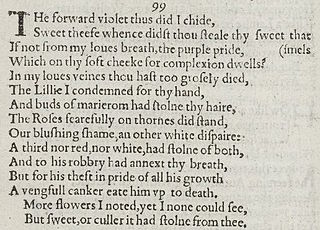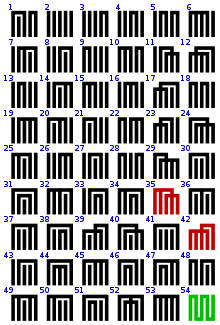A quatrain is a type of stanza, or a complete poem, consisting of four lines.

A sonnet is a poetic form that originated in the poetry composed at the Court of the Holy Roman Emperor Frederick II in the Sicilian city of Palermo. The 13th-century poet and notary Giacomo da Lentini is credited with the sonnet's invention, and the Sicilian School of poets who surrounded him then spread the form to the mainland. The earliest sonnets, however, no longer survive in the original Sicilian language, but only after being translated into Tuscan dialect.
A tercet is composed of three lines of poetry, forming a stanza or a complete poem.

Musophilus is a long poem by Samuel Daniel, first published in 1599 in his Poetical Essays.
Rhyme royal is a rhyming stanza form that was introduced to English poetry by Geoffrey Chaucer. The form enjoyed significant success in the fifteenth century and into the sixteenth century. It has had a more subdued but continuing influence on English verse in more recent centuries.
Terza rima is a rhyming verse form, in which the poem, or each poem-section, consists of tercets with an interlocking three-line rhyme scheme: The last word of the second line in one tercet provides the rhyme for the first and third lines in the tercet that follows. The poem or poem-section may have any number of lines, but it ends with either a single line or a couplet, which repeats the rhyme of the middle line of the previous tercet.
Common metre or common measure—abbreviated as C. M. or CM—is a poetic metre consisting of four lines that alternate between iambic tetrameter and iambic trimeter, with each foot consisting of an unstressed syllable followed by a stressed syllable. The metre is denoted by the syllable count of each line, i.e. 8.6.8.6, 86.86, or 86 86, depending on style, or by its shorthand abbreviation "CM".
A rondeau is a form of medieval and Renaissance French poetry, as well as the corresponding musical chanson form. Together with the ballade and the virelai it was considered one of three formes fixes, and one of the verse forms in France most commonly set to music between the late 13th and the 15th centuries. It is structured around a fixed pattern of repetition of verse with a refrain. The rondeau is believed to have originated in dance songs involving singing of the refrain by a group alternating with the other lines by a soloist. The term "Rondeau" is used both in a wider sense, covering older styles of the form which are sometimes distinguished as the triolet and rondel, and in a narrower sense referring to a 15-line style which developed from these forms in the 15th and 16th centuries. The rondeau is unrelated to the much later instrumental dance form that shares the same name in French baroque music, which is more commonly called the rondo form in classical music.
This is a glossary of poetry terms.

Sonnet 49 is one of 154 sonnets written by the English playwright and poet William Shakespeare. It is a member of the Fair Youth sequence, in which the poet expresses his love towards a young man.

Sonnet 61 is one of 154 sonnets written by the English playwright and poet William Shakespeare. It is a member of the Fair Youth sequence, in which the poet expresses his love towards a young man.

Sonnet 99 is one of 154 sonnets written by the English playwright and poet William Shakespeare. It is a member of the Fair Youth sequence, in which the poet expresses his love towards a young man. The sonnet is generally grouped with the preceding two in the sequence, with which it shares a dominant trope and image set: the beloved is described in terms of, and judged superior to, nature and its beauties.

Sonnet 148 is one of 154 sonnets written by the English playwright and poet William Shakespeare.
Sonnet 125 is one of 154 sonnets written by the English playwright and poet William Shakespeare. It is a member of the Fair Youth sequence, in which the poet expresses his love towards a young man.

Sonnet 119 is one of 154 sonnets written by the English playwright and poet William Shakespeare. It's a member of the Fair Youth sequence, in which the poet expresses his love towards a young man.

Sonnet 87 is one of 154 sonnets published by the English playwright and poet William Shakespeare in 1609. It is part of the Fair Youth sequence, and sometimes included as the last sonnet in the Rival Poet group.

Sonnet 95 is one of 154 sonnets written by the English playwright and poet William Shakespeare. It is a member of the Fair Youth sequence, in which the poet expresses his love towards a young man.

Sonnet 96 is one of 154 sonnets written by the English playwright and poet William Shakespeare. It is a member of the Fair Youth sequence.
Fixed verse forms are a kind of template or formula that poetry can be composed in. The opposite of fixed verse is free verse poetry, which by design has little or no pre-established guidelines.
Decasyllabic quatrain is a poetic form in which each stanza consists of four lines of ten syllables each, usually with a rhyme scheme of AABB or ABAB. Examples of the decasyllabic quatrain in heroic couplets appear in some of the earliest texts in the English language, as Geoffrey Chaucer created the heroic couplet and used it in The Canterbury Tales. The alternating form came to prominence in late 16th-century English poetry and became fashionable in the 17th century when it appeared in heroic poems by William Davenant and John Dryden. In the 18th century famous poets such as Thomas Gray continued to use the form in works such as "Elegy Written in a Country Churchyard". Shakespearean Sonnets, comprising 3 quatrains of iambic pentameter followed by a final couplet, as well as later poems in blank verse have displayed the various uses of the decasyllabic quatrain throughout the history of English Poetry.










